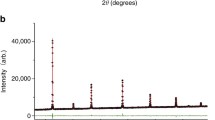Abstract
The high-Tc Y1Ba2Cu3O7−δ superconductor with oxygen ion vacancies was employed as the cathode for a high-temperature solid-oxide fuel cell (SOFC). The cathodic current-overpotential characteristics were studied in the temperature range from 500 to 800 °C and the oxygen pressure range from 10−4 to 0.21 atm. The delocalization of the triple-phase boundary and the oxygen reduction mechanism were identified. The delocalized triple-phase boundary of Y1Ba2Cu3O7−δ improves the cathodic polarization in SOFCs. By using a mathematical simulation and a particular experimental design, the oxygen adsorption step in the oxygen reduction process was demonstrated to be rate limiting. A layer of strong oxygen-adsorption catalyst such as Pt or Ag coated on the Y1Ba2Cu3O7−δ electrode was found to be able to largely enhance the activity of oxygen reduction by improving the ability of oxygen to be adsorbed on the electrode surface.
Similar content being viewed by others
Author information
Authors and Affiliations
Additional information
Received: 28 October 1997 / Accepted: 16 January 1998
Rights and permissions
About this article
Cite this article
Chang, CL., Lee, TC. & Huang, TJ. Oxygen reduction mechanism and performance of Y1Ba2Cu3O7−d as a cathode material in a high-temperature solid-oxide fuel cell. J Solid State Electrochem 2, 291–298 (1998). https://doi.org/10.1007/s100080050103
Issue Date:
DOI: https://doi.org/10.1007/s100080050103




